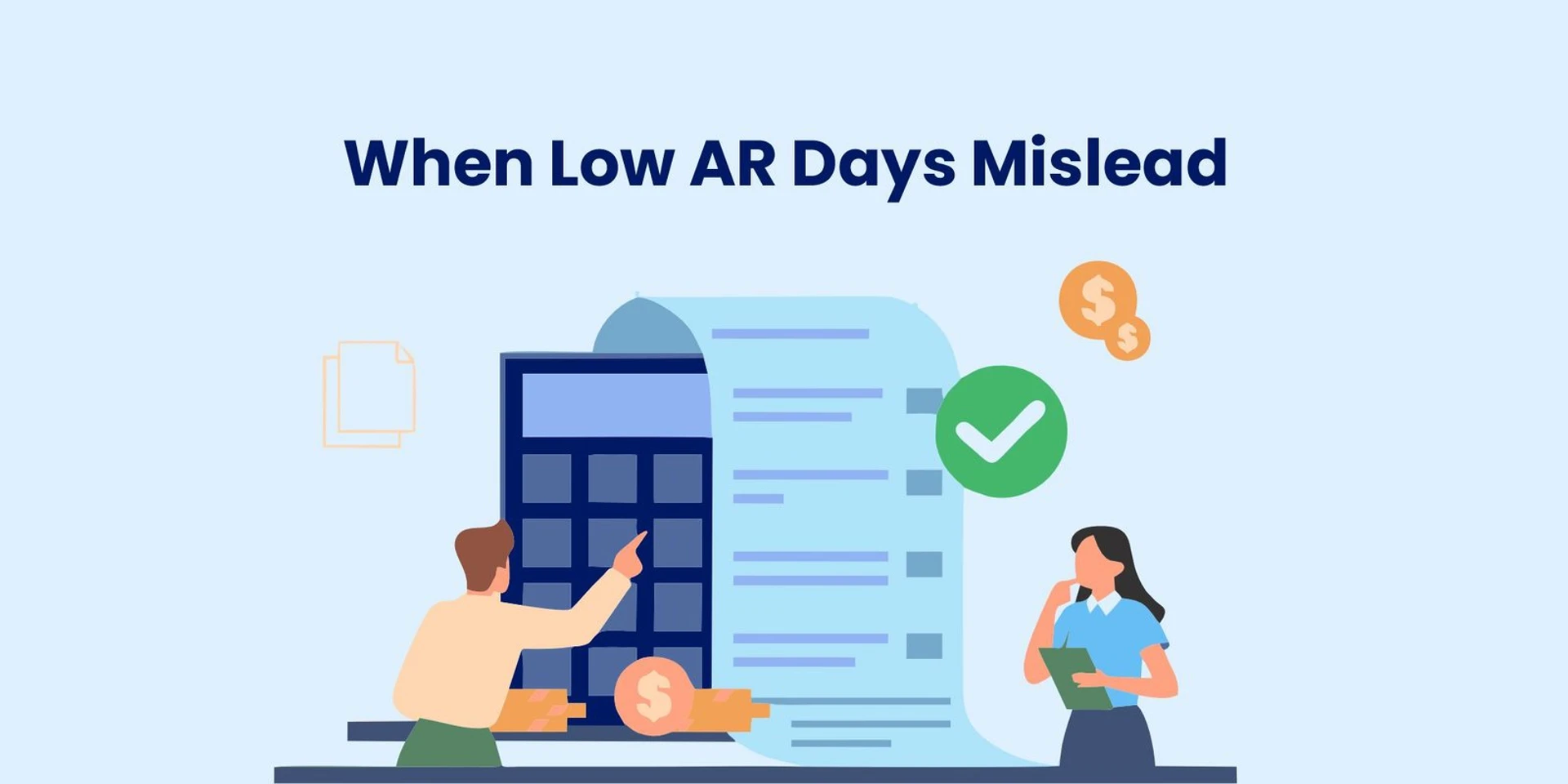A Coveted Trophy—Or Just Another Mirage in Healthcare RCM?
Low accounts receivable (AR) days may feel like a coveted trophy—a sign your team is crushing it with lightning-fast collections—but the metric can be pretty misleading in healthcare revenue cycle management (RCM).
Here’s the kicker. Without the right context, low AR days may not always mean real revenue cycle success. In fact, the metric can mask issues that could be silently impacting your bottom line.
Think of it like spotting an oasis in the desert—looks promising from a distance but is a mirage—nature’s way of playing tricks on your eyes. In the same way, low AR days can mislead you by painting the wrong picture of your revenue cycle. Let’s uncover the “why” and the “how”:
The ABCs of AR Aren’t That Simple
AR days primarily tell you the amount of time it takes to collect the payment for the healthcare service you deliver. So, yes, it’s natural to believe that lower AR days signal faster collections and a healthy cash flow. But, there’s more to it than meets the eye.
Myth: Low AR days = Your backend team is nailing it!
Truth: Low AR days might be hiding red flags under the hood.
Without the right context, low AR days are just a number and not the true picture of your RCM.
How Low AR Days Can Mislead Your RCM
While low AR days are a key RCM metric, they may not necessarily account for things like revenue capture accuracy, early write-offs, and payer mix. Thus, as a healthcare leader, you need to look beyond this metric to gain a deeper understanding of your revenue cycle health.
Let’s break down the reasons why this key RCM metric is sometimes misleading—or worse, dangerous.
Reason 1: Writing Off Denials Too Soon
In healthcare RCM, speed is great, but not at the cost of your revenue. Typically, a good indicator of your revenue cycle performance, low AR days can also result from the wrong kind of “speed”—especially when it involves clearing out claims with hasty write-offs.
When denials are written off too early instead of being appealed, your AR days may appear short. But in reality, you leave a significant amount of money on the table.
For instance, a clinic receives a medical necessity denial from a payer. Now, instead of taking a few minutes to review it and submit additional clinical documentation to reverse the denial, the clinic decides to write it off. While on paper, this may show lower AR days for the clinic; in reality, it buried their margins too, resulting in a missed revenue opportunity for the clinic. This isn’t efficiency; it’s revenue cycle bleeding money.
Any write-off done in haste can chip away your margins, turning revenue opportunities into a financial loss.
Writing Off Claims Hastily as Uncollectible = Lower AR Days = Revenue Loss
The good news: denials do not automatically relegate claims to the write-off bin. In fact, as many as two-thirds of rejected claims are recoverable. So, appealing the denials the right way can actually boost your bottom line and help you recover more revenue.
Reason 2: Not Keying In Claims in the First Place
Underbilling or not billing every service you’ve rendered—due to undercoding, missed charges, or incomplete documentation during charge capture—is bound to impact your AR days, your actual collections, and ultimately your bottom line.
Imagine a scenario where your front-end team forgets to capture a point-of-service test for an urgent care claim and processes the documentation. That means fewer charges captured, which will eventually result in missed revenue for your organization, irrespective of the low AR days the claim needed to be settled.
Missed Charges = Lower AR Days = Missed Revenue Opportunities
Reason 3: Having a Poor Mix of Payers
Not all fast payers are good for your revenue cycle health. Medicare, Medicaid, or capitated payers generally pay fast, but mostly pay less than the actual cost of care. The quick payments made by these payers might show a sharp drop in your AR days.
But in reality, you tend to collect way less than you spend on your patients. This clearly suggests that fast payers not necessarily translate into actual collectible collections.
Fast Payers = Lower AR Days = Fast but Low Collections
The Hidden Cost of Chasing Low AR Days
Too often, healthcare leaders chase KPIs that look good on their dashboards but don’t do any good to their revenue cycles, without realizing that metrics are only as good as their context.
Low AR days could paint a happy picture about your revenue cycle, but not the true picture. If dug deeper, it may be rife with untapped revenue opportunities or even setbacks that could be detrimental to your RCM in the long run.
Aggressive write-offs, missed charge capture, poor denial management, and bad payer contracts can actually hurt your bottom line, no matter how good your AR days might look on your RCM dashboard.
How You Should Measure Your Revenue Cycle Health
Pivoting your approach in healthcare RCM from solely seeing your AR days to pairing them up with metrics that reveal the true picture of your revenue cycle is what will help you see the big picture.
It’s equally important for you to take into consideration:
- Net collection rate—to know if you are collecting what you’re owed
- Denial rate—to know if your appeal workflows are robust enough
- Bad debts—to know how much revenue you are writing-off as uncollectible
- Gross charges—to know if you are billing every service correctly
Metrics need context. These KPIs, alongside your AR days, can give you a clearer view of your revenue cycle’s real health.
Start Digging Deep and Asking the Real Questions
The key to driving revenue is to dig deep and understand your revenue cycle KPIs in the right context to ensure you are headed in the right direction toward profitability. It’s important you peel back the layers behind your low AR days to see if you’re really doing well or silently bleeding money.
Before contentedly touting your billing “as great” and your billing system “in good shape,” ask:
- Are we missing any charges during billing?
- Are we writing off too much and too often?
- Are we collecting what we should ideally be?
- Are our payers dragging our net revenue down?
A Reality Check Your Revenue Cycle Needs
Not just average, even some of the high-performing healthcare organizations often fall into the “low AR days trap” that tells them a half-baked story.
In reality, it’s important to hit home and see beyond superficial AR metrics to uncover what’s truly impacting your bottom line.
At Jindal Healthcare, we go beyond the vanity RCM metrics to help you look at your bottom line from a critical lens and understand what’s truly impacting and driving your cash flow. From deep-down payer analysis, charge capture and bad debt audit to denial and AR management, we help you see the big picture and optimize your workflows with tech-enabled RCM expertise to achieve low AR days while maximizing your revenue.
Want real results with low AR days? Let’s talk about optimizing your revenue cycle—for a stronger bottom line.







